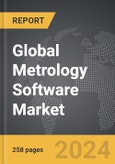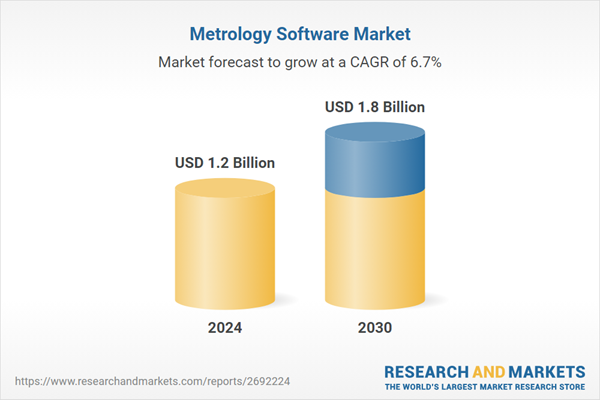Global Metrology Software Market - Key Trends and Drivers Summarized
Metrology software is a pivotal component in modern measurement systems across precision industries like aerospace, automotive, and optics. These advanced software solutions manage and enhance the performance of measuring instruments by analyzing and interpreting measurements, which is essential for maintaining quality control, conducting dimensional analysis, and improving process efficiency. The software plays a crucial role in ensuring that products adhere to strict specifications by enabling precise measurement, especially with the advent of 3D metrology. This specific technology allows for the accurate analysis of three-dimensional objects, providing detailed insights into the geometry, tolerances, and deviations of surfaces. Additionally, the integration of Artificial Intelligence (AI) in metrology software streamlines the measurement process by improving precision and speed, reducing human errors, and enabling quicker data analysis, which is particularly advantageous in sectors that demand high accuracy and rapid operations.The development and application of metrology software are increasingly influenced by the integration of modern technological trends such as cloud-based solutions, which offer enhanced flexibility and accessibility. Cloud technology allows secure storage and easy access to measurement data from any location, facilitating real-time data sharing and remote collaboration. This capability is integrated with other enterprise systems like Manufacturing Execution Systems (MES) and Enterprise Resource Planning (ERP) systems, optimizing production efficiency and adapting manufacturing techniques. Furthermore, the rise of portable and handheld metrology devices equipped with sophisticated software solutions is becoming prominent, as these devices allow for on-the-spot measurements and quick inspections, thereby enhancing convenience and operational flexibility. These advancements are complemented by improved visualization and reporting capabilities in modern metrology software, which provide users with intuitive visual representations of data and comprehensive analytical reports, aiding in informed decision-making and quality assurance.
The future of metrology software, characterized as Metrology 4.0, promises a transformation in measurement methodologies aligned with Industry 4.0 principles, focusing on automation, connectivity, and intelligent data utilization. Metrology 4.0 incorporates advanced technologies such as IoT, AI, cloud computing, and automation to enhance the precision, efficiency, and reliability of measurement processes. The software supports complex automated measurements and integrates seamlessly with statistical process control systems, offering sophisticated user interfaces for enhanced interaction and programming capabilities. Moreover, Metrology 4.0 facilitates connected metrology, enabling real-time data collection and analysis for optimized monitoring and control. This new paradigm also introduces predictive maintenance capabilities and digital twins technology, enhancing traceability and providing virtual models for simulations, which are crucial for modern manufacturing processes. As metrology software continues to evolve, it is set to redefine its role across various industries, fostering innovations that ensure precision and improve operational efficiencies in manufacturing and beyond.
Report Scope
The report analyzes the Metrology Software market, presented in terms of market value. The analysis covers the key segments and geographic regions outlined below.- Segments: Application (Manufacturing, Automotive, Aerospace & Defense, Power & Energy, Consumer Electronics, Healthcare, Other Applications).
- Geographic Regions/Countries: World; United States; Canada; Japan; China; Europe (France; Germany; Italy; United Kingdom; Spain; Russia; and Rest of Europe); Asia-Pacific (Australia; India; South Korea; and Rest of Asia-Pacific); Latin America (Argentina; Brazil; Mexico; and Rest of Latin America); Middle East (Iran; Israel; Saudi Arabia; United Arab Emirates; and Rest of Middle East); and Africa.
Key Insights:
- Market Growth: Understand the significant growth trajectory of the Manufacturing Application segment, which is expected to reach US$503.8 Million by 2030 with a CAGR of a 6.8%. The Automotive Application segment is also set to grow at 7.4% CAGR over the analysis period.
- Regional Analysis: Gain insights into the U.S. market, valued at $322.3 Million in 2024, and China, forecasted to grow at an impressive 9.7% CAGR to reach $418.7 Million by 2030. Discover growth trends in other key regions, including Japan, Canada, Germany, and the Asia-Pacific.
Why You Should Buy This Report:
- Detailed Market Analysis: Access a thorough analysis of the Global Metrology Software Market, covering all major geographic regions and market segments.
- Competitive Insights: Get an overview of the competitive landscape, including the market presence of major players across different geographies.
- Future Trends and Drivers: Understand the key trends and drivers shaping the future of the Global Metrology Software Market.
- Actionable Insights: Benefit from actionable insights that can help you identify new revenue opportunities and make strategic business decisions.
Key Questions Answered:
- How is the Global Metrology Software Market expected to evolve by 2030?
- What are the main drivers and restraints affecting the market?
- Which market segments will grow the most over the forecast period?
- How will market shares for different regions and segments change by 2030?
- Who are the leading players in the market, and what are their prospects?
Report Features:
- Comprehensive Market Data: Independent analysis of annual sales and market forecasts in US$ Million from 2024 to 2030.
- In-Depth Regional Analysis: Detailed insights into key markets, including the U.S., China, Japan, Canada, Europe, Asia-Pacific, Latin America, Middle East, and Africa.
- Company Profiles: Coverage of players such as ANP Technologies Inc., Aquanova AG, Blue California, Carlina Technologies, Encapsula NanoSciences LLC and more.
- Complimentary Updates: Receive free report updates for one year to keep you informed of the latest market developments.
Some of the 12 companies featured in this Metrology Software market report include:
- 3D Systems, Inc.
- Aberlink Ltd.
- AICON 3D Systems GmbH
- Automated Precision, Inc.
- BuildIT Software & Solutions Ltd.
- Carl Zeiss Industrial Metrology
- Creaform, Inc.
- Delcam Ltd.
- FARO Technologies Inc.
- GOM GmbH
- Heidenhain Corporation
- Hexagon AB
- Hexagon Manufacturing Intelligence
- Image Metrology A/S
- Innovative Metrology Solutions
- InnovMetric Software Inc.
- Kotem
- Metrologic Group SA
- Metrology Software Products Ltd.
- Micro-Vu Corporation
- Mitutoyo Corporation
- New River Kinematics, Inc.
- Nikon Corporation
- Optical Gaging Products
- Quality Vision International, Inc.
- RAM Optical Instrumentation
- Renishaw plc
- Rudolph Technologies, Inc.
- The L.S. Starrett Company
- Verisurf Software, Inc.
This edition integrates the latest global trade and economic shifts into comprehensive market analysis. Key updates include:
- Tariff and Trade Impact: Insights into global tariff negotiations across 180+ countries, with analysis of supply chain turbulence, sourcing disruptions, and geographic realignment. Special focus on 2025 as a pivotal year for trade tensions, including updated perspectives on the Trump-era tariffs.
- Adjusted Forecasts and Analytics: Revised global and regional market forecasts through 2030, incorporating tariff effects, economic uncertainty, and structural changes in globalization. Includes historical analysis from 2015 to 2023.
- Strategic Market Dynamics: Evaluation of revised market prospects, regional outlooks, and key economic indicators such as population and urbanization trends.
- Innovation & Technology Trends: Latest developments in product and process innovation, emerging technologies, and key industry drivers shaping the competitive landscape.
- Competitive Intelligence: Updated global market share estimates for 2025, competitive positioning of major players (Strong/Active/Niche/Trivial), and refined focus on leading global brands and core players.
- Expert Insight & Commentary: Strategic analysis from economists, trade experts, and domain specialists to contextualize market shifts and identify emerging opportunities.
Table of Contents
Companies Mentioned (Partial List)
A selection of companies mentioned in this report includes, but is not limited to:
- 3D Systems, Inc.
- Aberlink Ltd.
- AICON 3D Systems GmbH
- Automated Precision, Inc.
- BuildIT Software & Solutions Ltd.
- Carl Zeiss Industrial Metrology
- Creaform, Inc.
- Delcam Ltd.
- FARO Technologies Inc.
- GOM GmbH
- Heidenhain Corporation
- Hexagon AB
- Hexagon Manufacturing Intelligence
- Image Metrology A/S
- Innovative Metrology Solutions
- InnovMetric Software Inc.
- Kotem
- Metrologic Group SA
- Metrology Software Products Ltd.
- Micro-Vu Corporation
- Mitutoyo Corporation
- New River Kinematics, Inc.
- Nikon Corporation
- Optical Gaging Products
- Quality Vision International, Inc.
- RAM Optical Instrumentation
- Renishaw plc
- Rudolph Technologies, Inc.
- The L.S. Starrett Company
- Verisurf Software, Inc.
Table Information
| Report Attribute | Details |
|---|---|
| No. of Pages | 258 |
| Published | January 2026 |
| Forecast Period | 2024 - 2030 |
| Estimated Market Value ( USD | $ 1.2 Billion |
| Forecasted Market Value ( USD | $ 1.8 Billion |
| Compound Annual Growth Rate | 6.7% |
| Regions Covered | Global |









